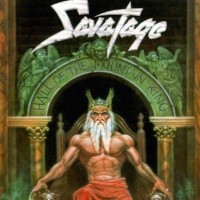After making a name in the metal community with their debut album Sirens and an EP The Dungeons are Calling released on indie label Combat Records, Savatage found themselves signing a major-label deal with Atlantic Records. They continued their metal ways on the 1985 Max Norman-produced release Power of the Night, but when it came time to record the follow-up for Atlantic, things started to come unraveled.
Vocalist and main composer Jon Oliva had been writing more pop-oriented songs for other artists on the label, but Atlantic decided that Savatage should record those songs for its next album. That was the beginning of Fight for the Rock, widely regarded by fans and the band as their worst album.
The fantasy and horror themes that permeated Savatage’s early records were mostly dropped for more of the pop-metal sound that was just beginning to come into fashion in the mid-1980s. The cover photo, which recreated the flag-raising over Iwo Jima with the band members, didn’t help matters. In fact, Fight for the Rock almost put the band’s career in a coffin before we got their best work.
But has it been unjustly maligned? Even being the Savatage fanboy that I am, I would have said a couple of days ago that Fight for the Rock was awful. Then I gave it an honest listen for this review – the first in many, many years – and the result was a bit surprising.
The album starts out on a not-so-bad note with the title track. The opening riff from the late Criss Oliva isn’t too far from what fans were used to. The “rockers vs. the world” lyrics that were popular at the time aren’t really up to par for Jon Oliva, but his vocals are great. It’s not as heavy and sinister as what we’re used to, but it’s not awful, either.
Up next is a re-recording of “Out on the Streets,” the ballad that originally appeared on Sirens. This version isn’t incredibly different, but it’s a little more polished and a little less dark than the original version.
So, now I’m three songs into my first listen to Fight for the Rock in years, and I’m beginning to wonder if it’s gotten a bad rap. I remember really not liking it, but “Crying for Love” has another great riff from Criss Oliva and his brother’s voice gives it kind of a dark air. I can certainly see this as the slower song on any of their releases.
But just as I’m starting to think Fight for the Rock might not be as bad as I remembered, we get the first of two covers, a version of Badfinger’s “Day After Day.” It’s not a bad update, but it’s a bad song for Savatage and sends things off the rails for a few minutes. The band fares better on the other cover, Free’s “Wishing Well,” giving it a heavier feel – but again, it just really doesn’t fit their style to that point.
There were only two songs from Fight for the Rock that Savatage performed live with any regularity, “Edge of Midnight” and “Hyde,” and they are two of the strongest songs. They keyboards on “Edge of Midnight” give it a definite mid-1980s pop rock feel, but strip those away, and it’s a pretty tough tune. “Hyde” might be the song that most fits with their work to that point. Take it out and put it on any of the previous three releases, and it would not have been out of place at all. It has the sound and theme of something from Sirens or Dungeons, and it’s easily the best track on this record.
Interestingly, there are a lot of hints at the more symphonic and varied sound that the band would adopt later on. You can hear it quickly on songs like “Lady in Disguise,” which with some tweaking to the arrangement would fit easily into the latter-day Savatage or Jon Oliva’s Pain catalog.
Listening to this for the first time in a while, I can certainly understand why myself and other Savatage fans in the 1980s absolutely hated it. But the truth is, Fight for the Rock is not really a bad record. I still think it’s their weakest effort, but I can hear the echoes of the three releases that came before and hints at some of what would come later. It’s interesting how perspective can change with years on an album you’ve always disliked, and I’ve discovered that a couple of times in writing this series.
Regardless of how you feel about Fight for the Rock, though, it did lead to the band’s biggest breakthrough. Savatage had lost some of its metal cred after the record, and Atlantic was threatening to cut them from the roster when Paul O’Neill, who had produced Aerosmith’s Classics Live albums, agreed to work with them. The result of that first collaboration was their masterpiece, 1987’s Hall of the Mountain King. It also ushered in an era of creativity and evolution that saw the band release a string of fantastic albums and, eventually, spin off the highly-successful Trans-Siberian Orchestra – which has introduced a much wider audience to the basic Savatage sound.
- How Black Sabbath’s Self-Titled Debut Invented a New Genre of Music - February 5, 2025
- Alestorm, Ratt, Zeal & Ardor + Others: Fred Phillips’ Best of 2024 Metal and Hard Rock Songs - January 26, 2025
- Cody Jinks, Blackberry Smoke + Others: Fred Phillips’ Best of 2024 Country and Southern Rock - January 20, 2025




